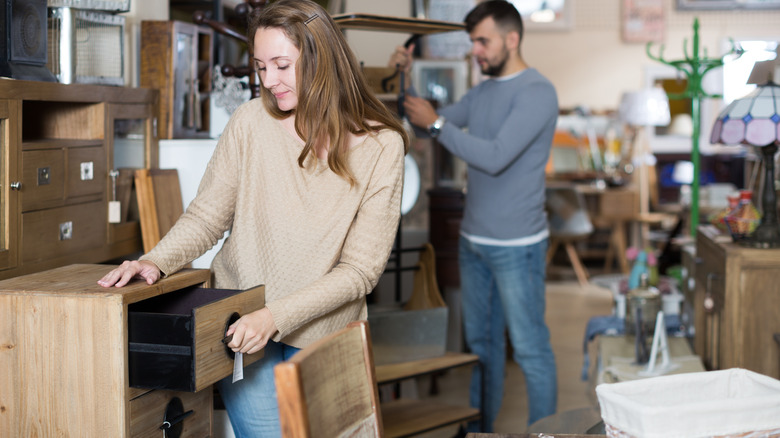Bring Life Back To Water-Damaged Cabinets By Giving Them A Beautiful Tile Upgrade
Here's a sobering thought: In 2018, Americans threw away 12.1 million tons of furniture, as reported by the United States Environmental Protection Agency. This staggering statistic gives us an idea of just how bad society's throwaway culture has gotten. So before throwing out that water-damaged cabinet collecting dust in your attic or garage, you may want to consider creative ways you can repurpose old furniture first. You can bring your cabinet back to life with a beautiful tile upgrade.
This is exactly what YouTuber @TheEssentialsClub set out to do with a wooden cabinet she found in her studio's bathroom. Its laminated wood had suffered from various watermarks, but its bones were still in good condition. With the help of colorful tiles, tile adhesive, grout, and a lot of patience during its drying time, she takes us through a DIY that transforms outdated furniture into stunning modern pieces. Don't be daunted if you're a DIY novice — this tiling project is an easy and enjoyable one that guarantees a stunningly original and eco-friendly furniture piece unlike any other. Just be sure to consult our list of tiling mistakes to avoid before starting.
Sand down, measure, and tile the cabinet
Start off by protecting the façade of the cabinet with masking tape. You'll want to sand down and clean the surfaces to ensure a smooth and even palette to work with. Measure the cabinet's dimensions carefully; this will help you select the appropriately-sized tiles that will evenly cover the entire length and width of the surfaces and sides. Lay the tiles down first to visualize the effect and pattern you want to achieve. When you're satisfied with the way the tiles look, you can now glue them one by one onto the surface with tiling adhesive. Follow the same process for the cabinet's sides.
Once the tiles are dry, prepare your grout according to the product's instructions — unless you are using pre-mixed grout. Spread grout across the tiles, pressing it into the joints with a grout float or with your fingers. Briskly run a grout sponge over the tiles to remove the excess product. Work in sections to prevent the grout from drying out. Leave it to dry for a period of 24 to 72 hours before proudly displaying your newly-revived cabinet around your home. You can use this DIY to recycle coffee tables, side tables, or a small buffet, so keep those tile ideas in mind the next time you're cruising a secondhand market or thrift shop. While YouTuber @TheEssentialsClub used tiles along the sides of the cabinet, you can opt to cover just the surface of the table or cabinet if you prefer.
